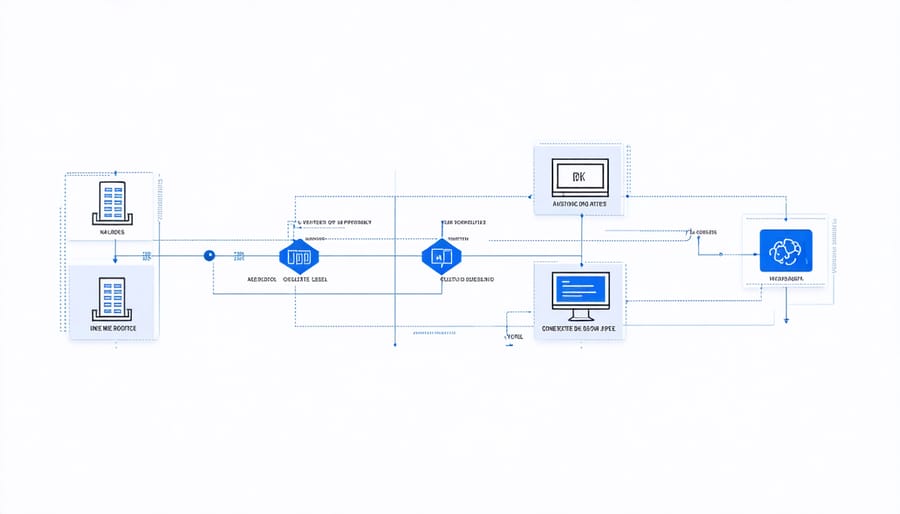Imagine a world where every digital interaction feels like it was crafted exclusively for you – that’s the promise of AI-powered hyper personalization. By analyzing thousands of data points in real-time, artificial intelligence is revolutionizing how businesses connect with their customers, delivering experiences so tailored they seem almost intuitive.
Today’s consumers expect more than simple product recommendations; they demand seamless, contextual experiences that anticipate their needs before they even arise. Hyper personalization AI makes this possible by combining advanced machine learning algorithms with rich customer data to create uniquely personalized experiences across every touchpoint.
From Netflix’s uncannily accurate content suggestions to Spotify’s weekly playlists that seem to read your mind, AI-driven hyper personalization has become the invisible force shaping our daily digital interactions. This technology isn’t just improving customer satisfaction – it’s fundamentally transforming how businesses operate, driving unprecedented engagement rates and loyalty while generating significant ROI.
As we stand at the intersection of big data and artificial intelligence, hyper personalization represents the next frontier in customer experience – where every interaction is meaningful, relevant, and precisely tailored to each individual’s preferences and behaviors.

What Makes Hyper-Personalization Different
Real-Time Decision Making
Real-time decision making in hyper personalization AI operates like a sophisticated digital concierge, processing vast amounts of user data within milliseconds to deliver tailored experiences. The AI system continuously analyzes incoming data streams, including browsing behavior, purchase history, and contextual information such as time of day and device type, to make instant personalization decisions.
These systems employ advanced machine learning algorithms that work in three quick stages. First, they gather real-time signals from user interactions. Next, they compare this information against historical data patterns and predetermined rules. Finally, they generate personalized recommendations or content adjustments that best match the user’s current context and preferences.
For example, when you open an e-commerce app, the AI might instantly process your previous purchases, current location, and seasonal trends to reorganize the product display in real-time. If you’re browsing during lunch hours and have previously ordered food, the system might prioritize showing nearby restaurants that match your dietary preferences.
This instantaneous processing ensures that each user interaction is meaningful and relevant, significantly improving engagement and satisfaction while maintaining a seamless user experience.
Predictive Analytics
At the heart of hyper-personalization lies predictive analytics, where AI algorithms analyze vast amounts of user data to anticipate future behaviors and needs. These intelligent systems process historical interactions, browsing patterns, purchase history, and even contextual data like time of day or weather conditions to create increasingly accurate predictions about what users might want next.
Think of it as having a digital personal assistant that not only remembers your preferences but also understands the subtle patterns in your behavior. For example, an e-commerce platform might notice that you tend to buy running shoes every six months and automatically show you relevant options just before you’re due for a replacement. Similarly, a streaming service might recognize that you enjoy watching documentaries on weekends and action movies on Friday nights, adjusting its recommendations accordingly.
The real power comes from AI’s ability to identify correlations that humans might miss. By processing thousands of data points simultaneously, these systems can uncover hidden preferences and make surprisingly accurate predictions about user needs, often before users themselves realize what they want.
The Technology Behind AI Hyper-Personalization
Machine Learning Models
Understanding machine learning fundamentals is crucial for implementing hyper-personalization solutions. Several key ML models drive these sophisticated personalization systems, each serving unique purposes in creating tailored user experiences.
Collaborative Filtering models analyze user behavior patterns and preferences to make recommendations based on similarities between users. For example, if User A and User B both enjoy action movies, the system might recommend to User A other films that User B has rated highly.
Content-Based Filtering systems focus on item characteristics and user preferences, creating detailed profiles that match users with relevant content. Think of it as a smart matchmaker that understands both what you like and why you like it.
Deep Learning Neural Networks excel at processing complex user data and identifying subtle patterns in behavior. These sophisticated models can analyze multiple data points simultaneously, from browsing history to click patterns, creating highly accurate user profiles.
Random Forest algorithms help in decision-making processes by considering multiple factors at once. They’re particularly effective in predicting user preferences based on historical data and demographic information.
Natural Language Processing (NLP) models analyze user communications, reviews, and social media interactions to understand sentiment and context, enabling more nuanced personalization strategies. These models can interpret user intent and emotional responses, making recommendations more relevant and timely.
Data Processing Pipeline
The data processing pipeline for hyper-personalization AI begins with comprehensive data collection from multiple touchpoints. This includes user interactions, browsing behavior, purchase history, social media activity, and demographic information. Smart algorithms continuously gather this data in real-time, creating a dynamic user profile that evolves with each interaction.
Raw data then undergoes cleaning and preprocessing, where irrelevant information is filtered out, and missing values are handled appropriately. The system standardizes various data formats and removes duplicates to ensure consistency. This cleaned data feeds into feature extraction processes, where meaningful patterns and characteristics are identified.
The next stage involves data aggregation and enrichment, where information from different sources is combined to create a holistic view of each user. Advanced machine learning models analyze this enriched data to identify correlations and extract valuable insights. For instance, the system might recognize that a user who browses fitness content in the morning is more likely to engage with healthy recipe recommendations during lunch hours.
The final stage transforms these insights into actionable recommendations through sophisticated AI models. These models use techniques like collaborative filtering, natural language processing, and deep learning to predict user preferences and generate personalized experiences. The entire pipeline operates in a continuous feedback loop, where each user interaction helps refine and improve future recommendations, making the system increasingly accurate over time.
To maintain data privacy and security, the pipeline implements robust encryption and anonymization protocols, ensuring compliance with relevant data protection regulations while delivering highly personalized experiences.

Real-World Applications
E-commerce Experiences
E-commerce platforms are revolutionizing the way we shop online by leveraging AI to create truly personalized shopping experiences. These systems analyze vast amounts of customer data, including browsing history, purchase patterns, and even mouse movements, to tailor every aspect of the shopping journey.
Major retailers like Amazon and Netflix have set the standard with their recommendation engines, which use sophisticated AI algorithms to suggest products based on both individual and collective shopping behaviors. For instance, when you browse for running shoes, the system doesn’t just show you similar footwear – it might recommend complementary items like moisture-wicking socks or running shorts based on what similar customers have purchased.
AI-powered personalization extends beyond product recommendations. Dynamic pricing adjusts in real-time based on factors like demand, inventory levels, and customer segments. Product descriptions and images adapt to match your preferences, while chatbots offer personalized assistance using your purchase history and browsing behavior to provide relevant suggestions.
The impact is significant: businesses implementing AI-driven personalization typically see a 10-15% increase in conversion rates and higher customer satisfaction scores. Shoppers benefit from more relevant product discoveries, streamlined navigation, and shopping experiences that feel uniquely crafted for their needs.

Content Platforms
Streaming platforms like Netflix, Spotify, and YouTube have revolutionized content delivery through AI-powered hyper-personalization. These platforms analyze vast amounts of user data, including viewing history, engagement patterns, and explicit preferences to create uniquely tailored experiences for each user.
Netflix’s recommendation engine, for instance, processes over 100 billion events per day to understand user preferences. The platform doesn’t just suggest content; it personalizes everything from thumbnail images to preview videos based on individual viewing habits. A thriller fan might see an action-packed thumbnail for a show, while a romance enthusiast sees a romantic scene from the same content.
Spotify takes personalization further with its Discover Weekly and Daily Mix features, using machine learning algorithms to analyze listening patterns, skip rates, and playlist creation behaviors. The platform even considers the time of day and user location to suggest appropriate content, such as workout playlists during morning hours or relaxing music in the evening.
YouTube’s algorithm personalizes not just recommendations but also ad delivery and video thumbnails. The platform processes users’ watch time, search history, and interaction patterns to create a unique content feed for each of its billions of users.
These platforms demonstrate how AI-driven personalization can significantly improve user engagement and satisfaction, with personalized recommendations accounting for up to 80% of content consumed on some platforms.
Implementation Challenges and Solutions
Privacy Concerns
While hyper-personalization offers remarkable benefits, it raises significant privacy concerns that businesses must address. The collection and analysis of vast amounts of personal data create potential vulnerabilities that could compromise user privacy and security. Organizations implementing these AI systems must strictly adhere to data privacy best practices and regulatory requirements like GDPR and CCPA.
Key concerns include the storage and protection of sensitive personal information, transparency in data collection methods, and user consent management. Users often worry about how their behavioral data, preferences, and personal details are being tracked and utilized. There’s also the risk of data breaches and unauthorized access to personalized profiles, which could lead to identity theft or misuse of personal information.
To maintain trust, companies must implement robust security measures, including data encryption, secure storage systems, and regular security audits. They should also provide users with clear control over their data, including options to opt-out of personalization features and the ability to delete their collected information when requested.
Technical Requirements
To implement hyper-personalization AI effectively, organizations need a robust technical foundation. At its core, a scalable cloud infrastructure is essential, capable of handling large volumes of data processing and real-time analytics. Popular platforms like AWS, Google Cloud, or Azure provide the necessary computing power and storage capabilities.
Data collection and management systems are crucial components, requiring both structured and unstructured data storage solutions. Organizations should implement secure databases and data lakes to store customer information, behavioral data, and interaction histories.
Machine learning frameworks and tools are necessary for building and training personalization models. Popular options include TensorFlow, PyTorch, or specialized AI platforms designed for personalization. These should be supported by powerful GPUs or TPUs for efficient model training.
Real-time processing capabilities are vital, requiring event streaming platforms like Apache Kafka or Amazon Kinesis. Integration APIs and microservices architecture enable seamless connection between different system components, while robust security measures protect sensitive customer data.
Additionally, organizations need analytics tools for monitoring and optimization, along with A/B testing capabilities to measure the effectiveness of personalization strategies.
As we look toward the future, AI-powered hyper-personalization is poised to revolutionize how businesses interact with their customers. The convergence of advanced machine learning algorithms, big data analytics, and increasingly sophisticated AI models will enable unprecedented levels of personalization across all customer touchpoints.
We’re already witnessing the emergence of more nuanced and context-aware personalization systems that can adapt in real-time to subtle changes in user behavior and preferences. These systems will continue to evolve, becoming more sophisticated in their ability to predict customer needs and deliver truly individualized experiences.
The impact of this evolution will be far-reaching. From healthcare providers offering personalized treatment plans to retailers creating unique shopping experiences, AI-driven personalization will become a cornerstone of customer engagement strategies. However, this future also brings important considerations about privacy, data security, and ethical AI use that organizations must carefully navigate.
For businesses and technology professionals, staying ahead of these developments will be crucial. Success will depend on striking the right balance between leveraging advanced AI capabilities and maintaining transparent, trustworthy relationships with customers. Organizations that can effectively implement hyper-personalization while respecting user privacy and preferences will gain a significant competitive advantage in their respective markets.
As we embrace this new era of personalization, one thing is clear: the future belongs to those who can harness AI’s power to create meaningful, personalized experiences while building lasting customer relationships based on trust and value.

